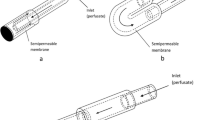Abstract
In vivo microdialysis sampling coupled to liquid chromatography was used to study acetaminophen disposition in anesthetized rats. The pharmacokinetics of acetaminophen and its sulfate and glucuronide metabolites were determined using both microdialysis sampling and collection of whole blood. For microdialysis, samples were continuously collected for over 5 hr without fluid loss using a single experimental animal. Microdialysis sampling directly assesses the free drug concentration in blood. The pharmacokinetic results obtained with microdialysis sampling were the same as those obtained from blood collection. The administration of heparin, necessary when collecting blood samples, was found to double the elimination half-life of acetaminophen. Microdialysis sampling is a powerful tool for pharmacokinetic studies, providing accurate and precise pharmacokinetic data.
Similar content being viewed by others
REFERENCES
M. Rowland and T. N. Tozer. Clinical Pharmacokinetics: Concepts and Applications, Lea & Febiger, 1989.
P. Arner, J. Bolinder, A. Eliasson, A. Lundin, and U. Ungerstedt. Microdialysis of adipose tissue and blood for in vivo lipolysis studies. Am. J. Physiol. 225:E737–E742 (1988).
U. Ungerstedt. In C. A. Marsden (ed.), Measurement of Neurotransmitter Release in Vivo, Wiley-Interscience, Chichester, 1984, pp. 81–105.
U. Ungerstedt, C. Forster, M. Herrera-Marschitz, I. Hoffman, U. Jungnelius, U. Tossman, and T. Zetterstrom. Brain dialysis—a new in vivo technique for studying neurotransmitter release and metabolism. Neurosci. Lett. (Suppl.) 10:493 (1982).
M. Sandberg and S. Lindstrom. Amino acids in the dorsal lateral geniculate nucleus of the cat—collection in vivo. J. Neurosci. Methods 9:65–74 (1983).
D. O. Scott, L. R. Sorenson, and C. E. Lunte. In vivo microdialysis sampling coupled to liquid chromatography for the study of acetaminophen metabolism. J. Chromatogr. 506:461–469 (1990).
J. Feigenbaum and C. A. Neuberg. Simplified method for the preparation of aromatic sulfuric acid esters. J. Am. Chem. Soc. 63:3529–3530 (1941).
A. M. Herrera, D. O. Scott, and C. E. Lunte. Microdialysis sampling for determination of plasma protein binding of drugs. Pharm. Res. 7:1077–1081 (1990).
USP Drug Information 9th ed., 1989, pp. 225–231.
Drug Evaluation, 6th ed., American Medical Association, 1988, p. 296.
J. A. Hinson, T. J. Monks, M. Hong, R. J. Higet, and L. R. Pohl. 3-(Glutathion-S-yl)acetaminophen: A biliary metabolite of acetaminophen. Drug Metab. Disp. 10:47–50 (1982).
M. Hamilton and P. T. Kissinger. Determination of acetaminophen metabolites in urine by liquid chromatography/electrochemistry. Anal. Biochem. 125:143–148 (1982).
Author information
Authors and Affiliations
Rights and permissions
About this article
Cite this article
Scott, D.O., Sorenson, L.R., Steele, K.L. et al. In Vivo Microdialysis Sampling for Pharmacokinetic Investigations. Pharm Res 8, 389–392 (1991). https://doi.org/10.1023/A:1015862003147
Issue Date:
DOI: https://doi.org/10.1023/A:1015862003147



